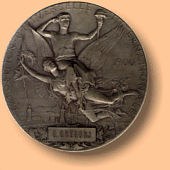 |
Products of the Kiln
|
Awards |
| 1881 - Milan |
| 1884 - Turin |
| 1888 - Treviso |
1895 and 97 - Rome |
| 1895 and 97 - Rome Agriculture, Industry and Business Ministry |
| 1897 - Venice Veneto Region Institute for Science, Literature and the Arts |
| 1898 - Turin General Industry Exposition |
| 1898 - Turin Sacred Art Exposition |
| 1899 - Como Gold Medal |
| 1900 - Verona Gold Medal |
| 1900 - Paris Universal Fair - Silver Medal |
| 1900 - Udine Diploma of Honour |
| 1900 - Naples Grand Diploma - Sanitary Engineering |
| 1908 - Udine Gold Medal |
| 1906 - Milan International Fair - Gold Medal |
| 1907 - Venice Building Art; |
1910 - Brussels |
| 1921 - Vicenza |
| 1925 - Monza International Fair of Decorative Arts |
| 1930 - Barcelona International Exposition - Gold Medal |
The production of the bricks is notable and varied and the bricks have been used in many buildings in Venice (the Military Arsenal, The Fondaco dei Turchi, at the church of Saints John and Paul, at the Palazzo of the International Artistic Exhibition, at Molino Stuckey, in the bell tower of Torcello, etc.).
Many products were fruit of accurate research and studies, both aesthetic and functional, as was widely illustrated and documented in the presentations which the kiln prepared regularly.
In a presentation by the company in 1903 following works were listed:
The participation at the fairs held in Italy and internationally represent the confirmation of a continuous commitment both to the technique of the workmanship of the materials and to the “search for beauty” that had so much importance between the end of the nineteenth century and the first decades of the twentieth century.
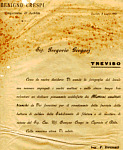 The awards followed
one after the other from 1881 until 1930, notwithstanding the evolution of tastes of the
people and the changes due to the wartime events and political transformations. The list
on the page shows on the most important awards won and would be much longer if it included
all the testaments published in the publications of the time, Italian and international.
The awards followed
one after the other from 1881 until 1930, notwithstanding the evolution of tastes of the
people and the changes due to the wartime events and political transformations. The list
on the page shows on the most important awards won and would be much longer if it included
all the testaments published in the publications of the time, Italian and international.
A singular event happened in Como in 1899, where the Gregorj Kiln was awarded the Gold Medal. When the buildings of the fair caught fire, in the Corriere della Sera it was written: "…But a few steps away, the spectacle of the ruins gripped the heart! It seemed that a magical force had made the beautiful scene disappear that took shelter here before us and substituted it with the scene of the hills of S. Fermo – The levelling force of the fire allowed the kitchen of the great families to rise of above the desert of ashes; the factory of the Caldaie, whose walls are covered with majolica bricks from the exposition of Cav. Gregorio Gregorj of Treviso, which resisted that infernal heat…" (from the Corriere della Sera from 11-12/July/1899, year XXIV, number 188).
 |
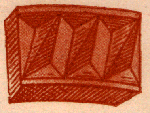 |
| Specially moulded bricks used in the façade of the provincial building of Treviso, 1200's style. Research done by the Guerra-Gregorj Kilns drawn from antique constructions in Treviso. | |
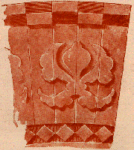 |
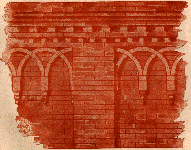 |
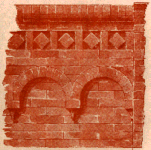 |
Facsimiles of Treviso terracotta derived from antique constructions. |
||
|
|
© Luisa Gregorj 2002 |